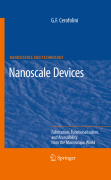
Nanoscale devices: fabrication, functionalization, and accessibility from the macroscopic world
Cerofolini, G.
The evolution of the microelectronics is controlled by the idea of scaling. However, the scaling of the device size below 10 nm is expected to be impossible because of physical, technological and economic reasons. Fundamental considerations (based on Heisenberg's principle Schroedinger equation, decoherence ofquantum states, and Landauer limit) suggest that a length scale of a few nanometers is possible. On this length scale, reconfigurable molecules (via redox or internal excitation processes) seem to be suitable for that. Moreover, crossbar with cross-point density in the range 1010 - 1011 cm² can already be prepared with existing methods, and such methods permit the link of nanoscopic cross-points to lithographically accessible contacts. The structures for molecular electronics deal with molecules. Although this subject is highly interdisciplinary (covering quantum and statistical mechanics, supramolecular chemistry, chemistry of surfaces, and silicon technology and devices), the book is intended to be self-contained providing in appendices the necessary side knowledge. Deals with the miniaturization of electronic devices towards the nanoscale Presents the concept of nanolithography and nanodevices A reference work for researchers and engineers alike INDICE: 1. Matter on the nanoscale.- 2. Top-down paradigm to miniaturization.- 3. Physical limits to miniaturization.- 4. The crossbar structure.- 5. Crossbar production.- 6. The litho-to-nano link.- 7. Functional molecules.- 8. Grafting functional molecules.- 9. Examples.- 10. Self-similar nanostructures.-11. Molecular motors.-12. Nanobiosensing.- 13. Abstract technology.
- ISBN: 978-3-540-92731-0
- Editorial: Springer
- Encuadernacion: Cartoné
- Páginas: 240
- Fecha Publicación: 01/03/2009
- Nº Volúmenes: 1
- Idioma: Inglés
